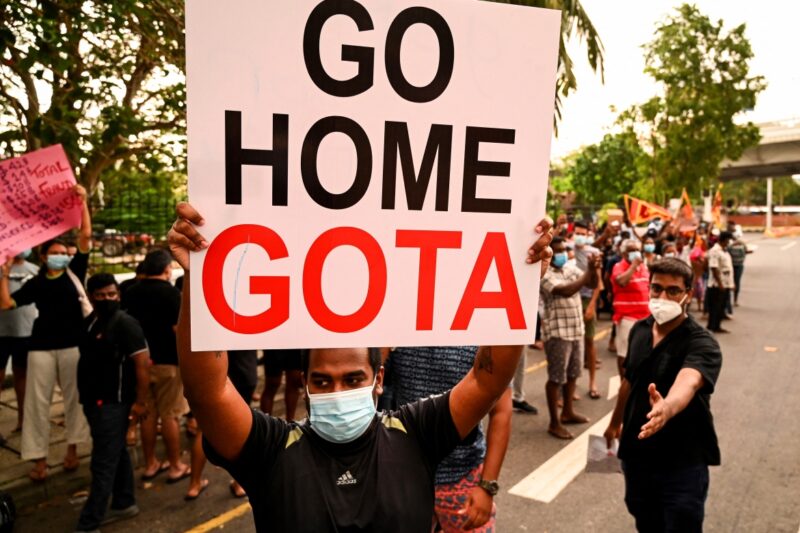Despite being South Asia’s oldest democracy, having constituted a universal franchise as early as 1931, the island nation of Sri Lanka is far from donning the hat of a stable one and the path toward democratic prosperity remains murky.
The country has seen a bloody civil war between the minority separatist Tamil Hindu community and the ruling Sinhala Buddhist majority from 1983 to 2009. Post-war, its polity has been turning the page for the worse toward an authoritarian and hyper-militarized state under the stewardship of the Rajapaksa family, which has sowed its members in multiple important government positions.
The frontrunner of the family and Sri Lanka’s current President, Gotabaya Rajapaksa, has today found himself at the centre of boiling anger on the streets over his mismanagement of the economy, leading to the biggest economic crisis since the country’s independence in 1945.
Ailing with a host of structural issues within the state machinery of Sri Lanka, ordinary citizens who had put their faith in the Rajapaksa government’s Sinhalese nationalist project are starting to turn against the dynasty rule. Change in this nation seems eminent, but what does change look like? To answer this question, we can begin by understanding how the post civil-war state was set up to create conditions for a failing state and the on-ground situation during the current economic crisis.
The Governance Crisis
While most media outlets have been focusing on the economic aspects of this crisis, Sri Lanka had been going through a much more deep-rooted crisis of governance that has set up the stage for its near collapse. Since 2009, when the ruling Sinhalese nationalist government decisively and unexpectedly defeated the separatist group Tigers of Tamil Eelam (LTTE), the Rajpaksas have been in power for most of the period. The current president’s older brother, Mahinda Rajapaksa was the president from 2005 to 2015 and is now the prime minister. In 2019, Gotabaya Rajapaksa won the presidency with 52% of the vote share and his party, the Sri Lanka People’s Front or SLPP enjoyed a supermajority in the parliament.
This grip that the Rajapaksa family have had over the Sri Lankan state has resulted in policies that mainly benefit the ruling family and the Sinhalese majority. Violence against the Hindu Tamil minority and the even smaller Muslim and Catholic minority groups has been well documented. Since a major source of employment for the Sinhalese community is in the military, there has been widespread acceptance of increased military presence on the streets and further colonisation of the country’s Northern and Eastern provinces, where the minority population is concentrated.
Infrastructure and other investments taken under this government have resulted in numerous dead or sinking assets for the state. Not only is this affair costly for the public, who pay for the Rajapaksa’s self-aggrandization (for example, the Mahinda Rajapaksa Cricket Stadium), it distracts from actual governance projects which have been given petty attention. Even civil society organizations have been silenced, journalists have ‘disappeared’ and political opponents have been humiliated.
Civilians, even those who have previously supported the government’s agenda, have now come out to protest against Gotabaya. The slogan most prominent during protests is “Go Home Gota” after every other member than the president and his brother had resigned from the cabinet, including the finance minister who was sworn in just a day before. The public sentiment right now seems to be to oust the Rajapska family and move on.
The Economic Crisis
The most jarring tell of the true severity of this crisis can be seen on the streets in the country’s capital Columbo. The city has been plunged into darkness with electricity cuts lasting for more than ten hours at a time. Essential supplies are sparse to find, including food and medicine – this has caused massive queues at shops and many hospitals have had to cancel routine services.
For Sri Lanka’s poorest, the situation is unforgiving — most people have to make the choice between standing in long lines or going to work. Transport is also in peril because of fuel insufficiency, there simply is not enough energy to power public transport or for taxis and rickshaws to make even a marginal earning. Prices for every good on the market have soared due to inflation. The middle class, despite having its safety net of household savings, has not been spared from this wide-reaching conflict.
On the macroeconomic level, the country’s foreign reserves of the US Dollar have been depleted to three times its sovereign debt due to the tourism sector–the major source of dollar earnings for the nation — being hit hard during the pandemic. This has led to banks being unable to finance the import of the essential items that have disappeared from the market shelves.
A shortage of the dollar also means that Sri Lanka will be unable to pay back the $51 billion debt it has taken from other countries and thus has led international agencies to downgrade the country’s credit rating. This has added to its woes by effectively cutting it off from international credit markets.
What’s next?
Looking at this monumental crisis from a comprehensive state, society and economy angle we can deduce that this really does appear to be a tipping point for Sri Lanka. Though, if we have learnt any lessons from the Arab Spring, we know that authoritarian leaders who have embedded their power deep into the structure of the state can quash widespread protests. It is now up to Sri Lankans to consolidate their anger across ethnic and religious lines to have a successful watershed moment.
Rutuparna Deshpande is a second-year student of Politics, Philosophy and Economics at Ashoka University.
Picture Credits: Balkan Times
We publish all articles under a Creative Commons Attribution-Noderivatives license. This means any news organisation, blog, website, newspaper or newsletter can republish our pieces for free, provided they attribute the original source (OpenAxis).

